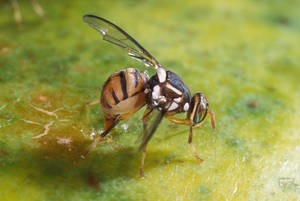Rome, Italy and Vienna, Austria
October 28, 2014

A female oriental fruit fly (Bactrocera dorsalis) laying eggs in the skin of a papaya.
Four of the world's most destructive agricultural pests are actually one and the same fruit fly, according to the results of a global research effort released today. The discovery should lead to the easing of certain international trade restrictions and also aid efforts to combat the ability of these harmful insects to reproduce, experts said.
The so-called Oriental, Philippine, Invasive and Asian Papaya fruit flies, the study shows, all belong to the same biological species, Bactrocera dorsalis, which is causing incalculable damage to horticultural industries and food security across Asia, Africa, the Pacific and parts of South America.
The international collaborative effort, involving close to 50 researchers from 20 countries, began in 2009 and was coordinated by FAO and the International Atomic Energy Agency (IAEA). It followed an integrative approach, examining evidence across a range of disciplines.
The ability to precisely identify pests is central to pest management, including quarantine measures or bans applied to internationally traded food and agriculture products such as fruit and vegetables.
Keeping exotic fruit flies out is a major concern for many countries. The study's findings mean that trade restrictions linked to the Oriental fruit fly should now fall away in cases where the insect is present in both the importing and exporting country, according to Jorge Hendrichs from the Joint FAO/IAEA Division of Nuclear Techniques in Food and Agriculture in Vienna.
"This outcome has major implications for global plant biosecurity, especially for developing countries in Africa and Asia," said the study's lead author, Mark Schutze, from the Plant Biosecurity Cooperative Research Centre (PBCRC) and the Queensland University of Technology (QUT).
"For example, the Invasive --now Oriental -- fruit fly has devastated African fruit production with crop losses exceeding 80 percent and has led to widespread trade restrictions with refusal of shipments of products into Asia, Europe and Japan, and significant economic and social impacts on farming communities," Schutze added.
Using sterilized males to mate with wild females
The findings of the study will also simplify techniques like the use of sterilized males to prevent the growth of pest populations.
A form of insect birth control, the sterile insect technique involves releasing mass-bred male flies that have been sterilized by low doses of radiation into infested areas, where they mate with wild females. These do not produce offspring and, as a result, the technique can suppress, if applied systematically on an area-wide basis, populations of wild flies in an environmentally friendly way. The FAO/IAEA Agriculture and Biotechnology Laboratories have demonstrated that the four fruit flies freely interbreed, which means that instead of using males from the four supposedly different species, mass-produced sterile Oriental fruit fly males can now be used against all the different populations of this major pest.
"Globally, accepting these four pests as a single species will lead to reduced barriers to international trade, improved pest management, facilitated transboundary international cooperation, more effective quarantine measures, the wider application of established post-harvest treatments, improved fundamental research and, most importantly, enhanced food security for some of the world's poorest nations," Schutze said.
The findings of the FAO/IAEA coordinated study, published in the journal Systematic Entomology means that the four, previously considered distinct fruit-fly species, will now be combined under the single name: Bactrocera dorsalis, the Oriental fruit fly.